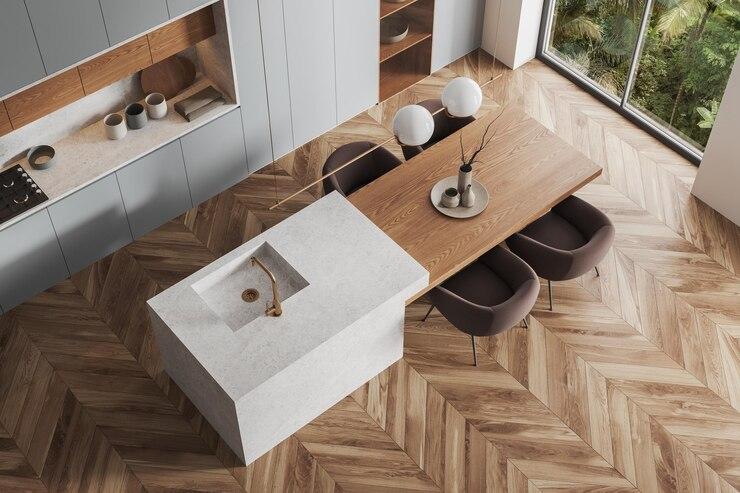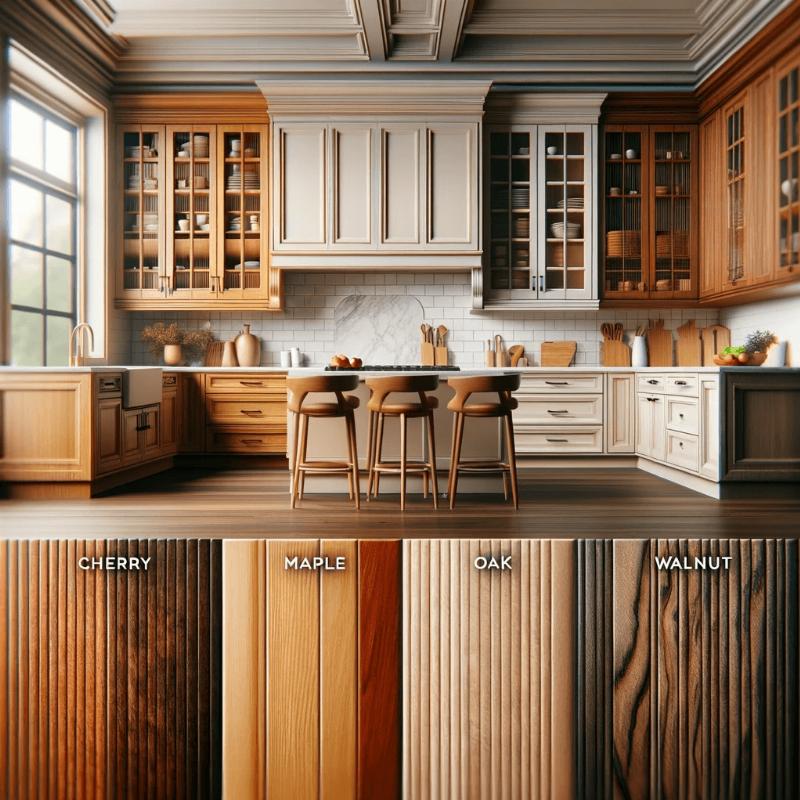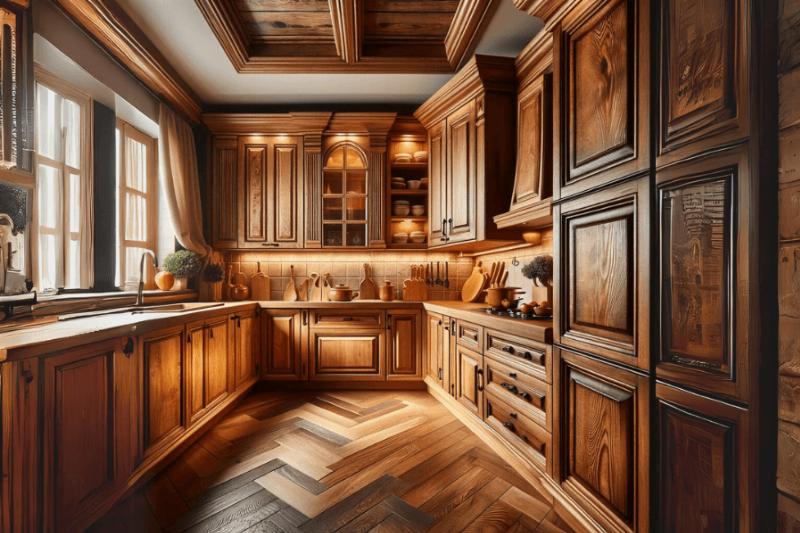Have you ever wondered why some cabinets come with a higher price tag even though they have the same style? Well, it’s because they’re made of different materials. The choice of wood not only affects the overall aesthetics of the cabinets but also their durability.
The kitchen is often considered the heart of a home. The cabinets serve as both functional storage and a significant design element. At Smart Remodeling LLC, for over a decade we have specialized in designing custom cabinets. We’ve installed lots of kitchen cabinets in homes and worked closely with our clients to help them choose the best wood for what they like.
In this article, we’ll check out seven popular types of wood for kitchen cabinets. So, keep reading!
Understanding Wood Types

Picking the right wood for your kitchen cabinets means knowing what makes each type special. Let’s discuss each type of wood in detail.
1. Hardwoods
Hardwood brings durability and a touch of elegance to your kitchen. With their robust nature and distinct grain patterns, they can withstand the test of time.
- Oak
Oak is one of the most popular choices for kitchen cabinets due to various factors. It’s readily available, affordable, and takes paints and stains well. Oak is recognized for its prominent grain, and it comes in a range of colors, from white to pink to reddish tones.
There are two main types of oak: red oak and white oak.
|
Characteristic |
Red Oak |
White Oak |
|
Color |
Lighter, reddish-brown to wheat |
Darker, grayer |
|
Common Uses |
Furniture and cabinets |
Whisky barrels, truck flooring |
|
Hardness |
Slightly softer |
Robust |
|
Staining Ability |
Stains well |
Stains well |
|
Moisture Resistance |
Good |
Excellent |
|
Grain Appearance |
Prominent grain with knots |
Prominent grain |
|
Versatility |
Gives Traditional look |
Adaptable to various styles |
- Cherry
Cherry wood is a fantastic choice for cabinets because it has a unique feature. It gets darker as it gets more sunlight. In terms of appearance, cherry cabinets have a smooth and fine-grain pattern. They come in warm tones ranging from red to reddish-brown.
Cherry wood is durable enough to withstand knocks and marring. So, it goes well with various styles, whether contemporary or traditional.
Cherry is on the more elegant side of the woods, and it’s priced accordingly. It’s considered a luxurious wood for kitchen cabinets and is quite expensive.
- Maple
Maple wood is a top pick for kitchen cabinets due to its smooth surface and similar grain pattern to birch. Maple has a generally straight grain with subtle waves and curls. Its color is a gentle white with reddish-brown hues.
Maple is often used for painted cabinets because, like birch, it’s less porous, reducing the chance of blotchiness when stained. They are more expensive than oak but less dense. Despite being less porous, maple is durable and can withstand temperatures well.
Maple wood goes well for light contemporary or farmhouse styles.
2. Softwoods
Softwood offers a warm and welcoming aesthetic to your kitchen space. Here are two famous softwoods.
- Pine
Being softwood, pine is softer than hardwoods like oak or maple. This softness means it can be more easily worked, cut, and shaped. Pine typically features a light color with a prominent, often knotty grain. This gives it a rustic, country-style appearance that’s popular in many kitchen designs.
While pine is durable enough for general use in cabinetry, it’s easier and more resistant to damage than hardwoods. It can be more prone to dents, scratches, and wear over time, especially in high-traffic areas of the kitchen.
The one great advantage of pine is that it’s usually cheaper than most hardwoods. It could be a good option for those on a budget or for larger kitchen projects.
- Cedar
Cedar is known for its rich, warm tones that range from reddish to pinkish hues. It often features a straight grain and a fine texture, which add a sophisticated and natural look to kitchen cabinets.
One great benefit of cedar is its natural aroma. This pleasant scent not only smells good but also works as a natural repellent for insects and moths, which is handy in a kitchen.
Even though cedar is a softwood, it’s surprisingly durable. It can handle the wear and tear of kitchen use quite well. Cedar has inherent moisture-resistant properties, making it less likely to warp or swell compared to some other types of wood.
3. Engineered Wood

Engineered wood strikes a balance between cost and quality. Let’s find out what engineered wood is best for kitchen cabinets.
- Plywood
Plywood is a type of engineered wood made by layering thin sheets of wood and gluing them together. This construction makes it resistant to water and prevents warping even under heavy loads. Plywood also has a cross-grain texture, making it convenient for holding nails and screws.
In the world of cabinets and drawers, plywood often plays a crucial role as the material for inner boxes. It’s cost-effective and lightweight and paints well, making it great for painted cabinets.
- MDF (Medium Density Fiberboard)
MDF is another type of wood material used in cabinets. Unlike solid wood, which can react to changes in humidity and temperature, MDF is less prone to warping. This is super useful when you need a flat and steady surface, like in cabinets or furniture.
MDF has a very smooth and even surface. You can have an idea to use it for a polished and flawless finish when painted or veneered. MDF is quite heavy because it’s packed with a lot of fibers and resin. While this makes it sturdy and smooth, it can be tricky when you need to lift or move big pieces of furniture or cabinets made from MDF.
Key Features of Wood Cabinets: What to Look For

When choosing wood for kitchen cabinets, several factors are crucial to consider. Let’s break down those factors.
1. Durability
Hardwood is generally more durable and resistant to scratches and dents. Examples include oak, cherry, and maple. They often last longer but may require less frequent but more careful maintenance.
In comparison, softwoods, like pine or cedar, are more prone to damage. These might not last as long as hardwoods but are often easier to repair or refinish.
2. Color
You can change the natural color of the wood using stain or paint. So, don’t worry too much about the original color. You can make birch look like maple with the right stain, or you can pick any color you like by painting.
3. Cost and Budget
Different woods come at different prices. Hardwood, which is tougher, usually costs more than softwood. If you’re looking at exotic woods, they can be even more expensive than the ones that are commonly available locally.
When deciding which wood to go for, it’s important to find a balance between quality and cost. Some hardwoods might be pricier, but they often last longer and need less maintenance. So, it’s a good investment over time. If you’re on a budget, there are alternatives like plywood or MDF.
4. Grain
In general, veneered cabinets, except those at the very high end, often provide superior grain-matching compared to solid wood cabinets. If achieving a consistent and well-matched grain pattern is a priority for you, veneered cabinets may be the more suitable option.
5. Construction
Look at how the cabinets are put together. Drawers can be made in different ways, like with rabbets, dowels, or dovetails. Dovetailed drawers last longer but can be more expensive because they use more wood. If you want something that lasts, dovetail construction might be worth the extra cost.
Cost Guidelines for Wood Alternatives
Choosing wood alternatives for cabinets can save money compared to traditional wood. Typically, for stock selections, you can expect to pay between $50 and $75 per linear foot for both wall and base cabinets.
You can expect high-pressure laminates to be pricier than lower grades; they boast increased durability, although repairs can be challenging. Thermofoil, another option, comes in the range of $35 to $45 per linear foot.
Behind laminates, vinyl film, or wood veneers, you’ll find manufactured wood products known as substrates. These include Particleboard, Plywood, or Medium-Density Fiberboard (MDF). These alternatives offer budget-friendly choices without compromising reliability. They use technology to provide sturdy and durable cabinet solutions for different preferences.
Design Custom Kitchen Cabinets with Smart Remodeling LLC
Do you live in Houston and dream of a kitchen that suits your style and needs perfectly? Smart Remodeling LLC is here to make it a reality with our custom kitchen cabinet design services. Our skilled designers offer a range of possibilities to ensure your cabinets are not just storage but also pieces of art. From choosing top-notch materials to selecting finishes that enhance your overall design, we make the design process smooth and enjoyable.
Wrap Up
The journey to selecting the perfect wood for your kitchen cabinets is a nuanced exploration of durability, style, cost, and customization. Whether you want the elegance of hardwoods like oak or cherry, the versatility of maple, or the rustic charm of softwoods, each wood type contributes its unique character to your kitchen.
Consider your lifestyle, aesthetic preferences, and budgetary constraints as you navigate the diverse world of cabinet woods.






